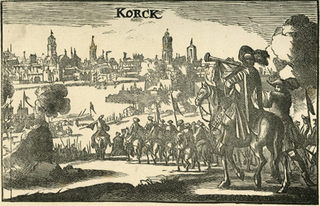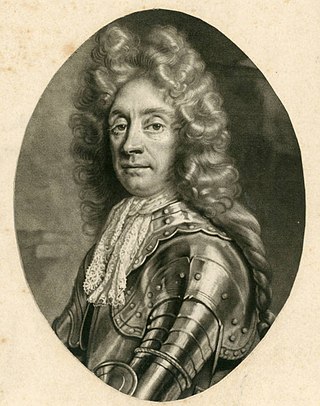Related Research Articles

The Battle of the Boyne was a battle in 1690 between the forces of the deposed King James II of England and Ireland, VII of Scotland, and those of King William III who, with his wife Queen Mary II, had acceded to the Crowns of England and Scotland in 1689. The battle took place across the River Boyne close to the town of Drogheda in the Kingdom of Ireland, modern-day Republic of Ireland, and resulted in a victory for William. This turned the tide in James's failed attempt to regain the British crown and ultimately aided in ensuring the continued Protestant ascendancy in Ireland.

Field Marshal Richard Boyle, 2nd Viscount Shannon, PC was a British Army officer and statesman. After serving as a junior officer at the Battle of the Boyne during the Williamite War in Ireland and at the Battle of Landen during the Nine Years' War, he commanded a brigade of grenadiers during the storming of Vigo during the War of the Spanish Succession. During this engagement the entire French fleet, under the command of the Marquis de Château-Renault, together with the Spanish galleons and transports under Manuel de Velasco, were either captured or destroyed. He also took part in a successful raid on Barcelona three years later. He went on to serve as Commander-in-Chief of the Royal Irish Army throughout the 1720s and 1730s.

Patrick Sarsfield, 1st Earl of Lucan, was an Irish soldier, and leading figure in the Jacobite army during the 1689 to 1691 Williamite War in Ireland.

The Treaty of Limerick, signed on 3 October 1691, ended the 1689 to 1691 Williamite War in Ireland, a conflict related to the 1688 to 1697 Nine Years' War. It consisted of two separate agreements, one with military terms of surrender, signed by commanders of a French expeditionary force and Irish Jacobites loyal to the exiled James II. Baron de Ginkell, leader of government forces in Ireland, signed on behalf of William III and his wife Mary II. It allowed Jacobite units to be transported to France, the diaspora known as the Flight of the Wild Geese.

The Williamite War in Ireland was a conflict between Jacobite supporters of deposed monarch James II and Williamite supporters of his successor, William III. It is also called the Jacobite War in Ireland, Williamite Conquest of Ireland, or the Williamite–Jacobite War in Ireland.

The Battle of Aughrim was the decisive battle of the Williamite War in Ireland. It was fought between the largely Irish Jacobite army loyal to James II and the forces of William III on 12 July 1691, near the village of Aughrim, County Galway.

Godard van Reede, 1st Earl of Athlone, Baron van Reede, Lord of Ginkel, born in the Netherlands as Baron Godard van Reede, was a Dutch general in Williamite service who rose to prominence during the Williamite War in Ireland.

Limerick, a city in western Ireland, was besieged twice in the Williamite War in Ireland in 1689–1691. On the first occasion, in August to September 1690, its Jacobite defenders retreated to the city after their defeat at the Battle of the Boyne. The Williamites, under William III, tried to take Limerick by storm but were driven off and had to retire into their winter quarters.

Henry Luttrell was an Irish soldier known for his service in the Jacobite cause. A career soldier, Luttrell served James II in England until his overthrow in 1688. In Ireland he continued to fight for James, reaching the rank of General in the Irish Army.

The siege of Cork took place during the Williamite war in Ireland in the year of 1690, shortly after the Battle of the Boyne when James II attempted to retake the English throne from King William III.
Lawrence Dempsey was an Irish soldier of the seventeenth century.

The siege of Carrickfergus took place in August 1689 when a force of Williamite troops under Marshal Schomberg landed and laid siege to the Jacobite garrison of Carrickfergus in Ireland. After a week the Jacobites surrendered, and were allowed to march out with the honours of war.
Sir Charles Carney was an Irish professional soldier, who later in his career became a Jacobite. He served as an officer in the Irish Army of James II during the Williamite War in Ireland.
The raid on Newry took place in November 1689 during the Williamite War in Ireland when a Franco-Irish force loyal to James II attacked the Williamite garrison of Newry in County Down. The raid was carried out by the French Major General Alexandre de Rainier de Droue, Marquis de Boisseleau a French officer serving with James' Irish Army. It was largely unsuccessful and the Jacobite forces withdrew having suffered casualties.

The Capture of Waterford took place in July 1690 during the Williamite War in Ireland when a force under the command of Percy Kirke captured the town of Waterford from its Jacobite Irish Army garrison. Full control of the town was not secured until Duncannon Fort across Waterford Harbour was also taken from its garrison under Michael Burke shortly afterwards. In both cases the garrisons were allowed to march out under escort to Jacobite-held Mallow in County Cork, but were denied the "honours of war" which they demanded.

William Dorrington was an English army officer. Contemporary sources often spell his surname as "Dorington", or "Dodington".

The Danish Auxiliary Corps was a corps of 7,000 Danish soldiers sent to fight with William of Orange who was at war in Ireland. Disappointed with his alliance with France's King Louis XIV, Christian V of Denmark in 1689 entered into a treaty of military assistance with King William III of England. The corps was transported to Ireland, fighting against the Jacobites, participating in the battles of the Boyne and Aughrim, as well as the sieges of Limerick, Cork, Kinsale, Athlone, and Galway. In early 1692 the corps was transported to Flanders for future service in English pay.

Thomas Maxwell was a Scottish professional soldier.
The Lord Grand Prior's Regiment, also known as Fitzjames' Regiment and as the Regiment of the Marine, was an infantry regiment originally raised in Ireland to fight for the deposed monarch James II during his war against his successor, William of Orange. While technically classed as a regiment of marines for much of its existence, as James possessed no navy it generally fought as conventional infantry. Its colonel was James's illegitimate son Henry Fitzjames, Grand Prior of the Knights of Malta, although in practice field command was delegated to an experienced lieutenant-colonel.
Colonel Roger McElligott was an Irish Jacobite soldier and politician.
References
- 1 2 Ó Ciardha, Éamonn (October 2009). "Barrett, John". Dictionary of Irish Biography. Retrieved 10 March 2023.
- ↑ GoIreland. Retrieved 12 September 2007
- ↑ O'Callaghan, John Cornelius. History of the Irish Brigades in the Service of France, from the revolution in Great Britain and Ireland under James II, to the revolution in France under Louis XVI. Cameron and Ferguson, 1883. Pages 172-74.